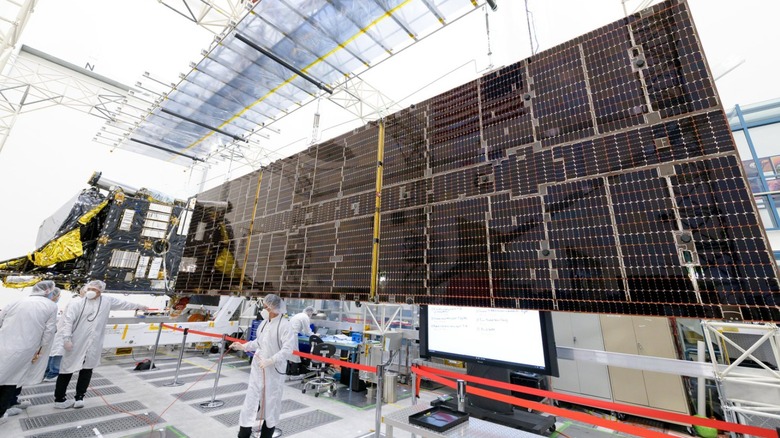NASA's Psyche Spacecraft Looks Astonishing Assembled For The First Time
NASA is getting ready to launch a spacecraft to visit a one of a kind target: the famous Psyche, a metal asteroid 140 miles across which has been claimed to be worth quintillions of dollars. NASA isn't visiting it for the money, though – the agency hopes to learn more about the early solar system and how this strange chunk of mostly metal came to be orbiting around our sun.
It's not an easy job to visit this space hunk, however, as it is located in the distant asteroid belt between Mars and Jupiter. That means a journey of 1.5 billion miles, or 2.4 billion kilometers. To get up and personal with this unique location, NASA is constructing a spacecraft, also called Psyche, and it has just had its solar arrays installed (via NASA).
The spacecraft's massive solar arrays will harness energy from the sun to provide power for the craft as it travels on its lonely journey through space, which will take three and a half years. The twin arrays cover a massive area of 800 square feet, or 75 square meters, which are the largest which have ever been installed at NASA's Jet Propulsion Laboratory, the location where robotic explorers like the Mars Perseverance rover are built.
"Seeing the spacecraft fully assembled for the first time is a huge accomplishment; there's a lot of pride," said Brian Bone, who leads assembly, test, and launch operations for the mission at the Jet Propulsion Laboratory in Southern California. "This is the true fun part. You're feeling it all come together. You feel the energy change and shift."
Challenges of the mission
One problem with solar powered space travel is that the further you get from the sun, the less energy you have available to you. So these arrays can generate 21 kilowatts of energy near Earth, which could power several homes, but by the time they reach their destination they'll only produce around 2 kilowatts. So engineers had to design the arrays accordingly. "These arrays are designed to work in low-light conditions, far away from the sun," said Peter Lord, Psyche technical director at Maxar Technologies, where the arrays were built.
Getting to the asteroid isn't the only challenging part of the mission though. Once Psyche arrives at its destination in 2026, it will have to get close enough to the asteroid to study it. The craft will spend nearly two years circling the asteroid, making very small adjustments to come closer and closer over time. It will study the asteroid using instruments including a magnetometer to measure magnetic fields and images for snapping photos of the asteroid, as well as tools called spectrometers which can determine the composition of an object by looking at the spectrum of light it gives off (via NASA).
All of this can help researchers learn more about what Psyche is made of, which is thought to be some combination of nickel, iron, and different kinds of rock. Though researchers aren't sure whether the rock and metals are separate, or whether they are all mixed together. They also want to find out if the asteroid could be the core of a planet which never fully formed, which could help us understand more about the very early formation of our solar system.
The Psyche mission is set to launch later this year, in 2022.
